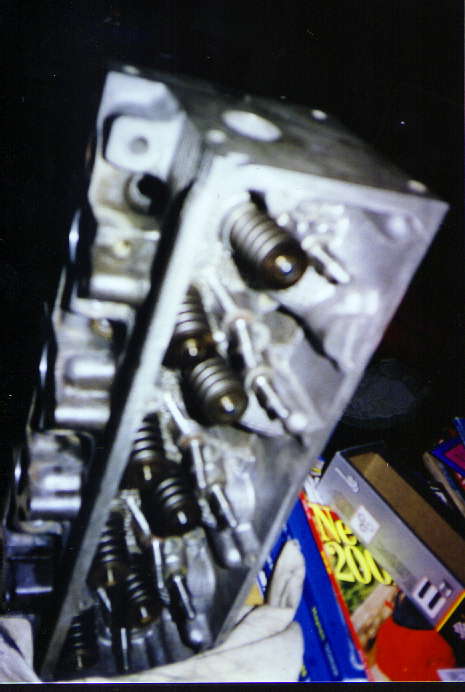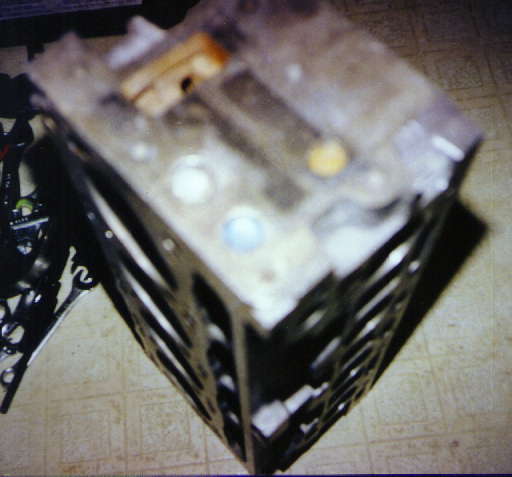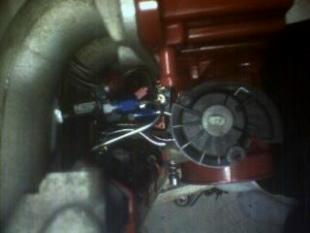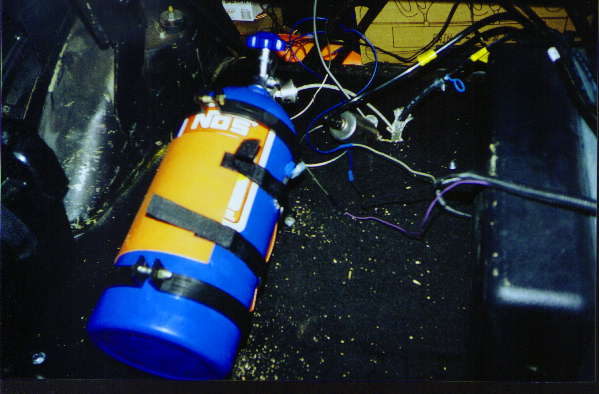
|

|
Here's what I stuffed into and onto the head :
I had an '88 head on my car when I was preparing for the swap. My stock '87 head had been sitting around collecting dust and bugs outside. I took it to JB Machine and they dipped it and checked for cracks, of which they found 2 on the exhaust seats of cyl. 2 and 3. They filled and repair the cracks, then decked the head .020. I then ported and polished it myself with a Standard Abrasives kit. Lots of material was removed. Lots. I gasket matched the head to the new intake, and finally cut the notches for the MPFI into the intake runners. I also had to relocate 2 intake manifold studs and plug the heater core passages in the head because the new manifold didnt allow for the same heater setup.

|

|
The springs were ordered by JB Machine from Comp Cams. We took the stock specs from the valve springs and searched through the books till we found something we liked. Higher compression rate with damper to handle to bigger cam and more aggressive profiles .
The roller tip rockers were ordered from Mantaparts, part #OP 1153R. It turns out they are just small block Chevy 1.6 rockers with adapter studs to work on the 2.0 head. Either way they add more lift, as opposed to the stock 1.5 ratio rockers. Of course I wish they would have either told me they were adjustable, or sent the sheet they were supposed to send with it for adjusting the rockers. I didn't find out until it was too late that they were the adjustable type. The header is a stock manifold from a '96 2.2L motor. I polished it and opened it up a bit myself. It will be replaced when the turbo comes along, if it does. JB Machine will probably be making the custom manifold for me. The intake was off a '93 2.2L motor out of the local junkyard. I polished the runners, and the throttle body. I plumbed the nitrous before installing the manifold. I'm considering an oversized TB, I'm just waiting for some good feedback or I'll do it myself. Fabricating a larger throttle plate isnt that hard. I'd like to get bigger injectors for it, I just don't have the cashflow right now. Actually, right now I'm in the process of creating a Ram Air throttle body. When it's done I'm gonna change the hood and add a ram air hood with K&N air filter. Basicly as it stands, I'm either going to use the ram air throttle body or a turbo.

|

|

|

|

The cold air intake is the old one from my buddies '96 Civic(ewww). I cut it and ran the intake towards the passenger side and through the hole where the vapor canister used to be on the inner fender. The under-inner fender has been boxed wuth sheet aluminum as a "sort-of" ram air through the bumper where my front turn signals used to be. I put a generic cone air filter on end. I'll be getting a K&N filter for it eventually.
The purge valve for the nitrous is routed so that when I purge the system it blows the gases on the intake runners to give 'em a quick freeze. Nitrous hits the air at about -127 degrees F. If that doesn't chill things out, nothing will. Just dont hold the purge too long or the temperature difference on the engine and cold nitrous may cause stress cracks from the sudden change in temp. Take a good look at the fuzzy pic of the head up there and you can see that the EGR passages have been plugged in the head (the silver and blue freeze plugs sitting next to each other). I case you dont know what the EGR valve is for I'll explain it to you. EGR stands for Exhaust Gas Recirculation. What happens is the EGR valve has an input passage leading it direct from exhaust runner in the head on cyl. 4. There is alos an output passage that runs to and then through the intake manifold to a hole that opens into the center of the intake. What happens is, depending on the amount of vacuum in the motor, the EGR pumps spent exhaust gases into the air/fuel mixture in the intake. What this does is increase air charge temperature and 'take up space' in the charge. By taking up space I mean this : when the intake valve opens, the piston drops and pulls in air/fuel from the intake manifold. The exhaust thats been pumped into the intake replaces some of the fresh air/fuel so that there is less to burn in the cylinder. This and the temp increases help emissions to be cleaner. The problem is you loss a bit of power because there is less air/fuel in the cylinder to burn and hotter air/fuel makes less power. Just to make sure I dont get any unwanted gas leaking I made a block off plate with sheet metal that sits under the EGR valve. Also the pipe that delivers the exhaust gas on a MPFI manifold has been removed and holes plugged. The thermostat is one I researched in the books at work and finally came up with one that would work for 180 degrees. Go to your local parts shop and buy a thermy for a Toyota Tercel (up to 98) or a 95-98 Nissan 200SX Stant part# 13758 or #29758 (its the same thermostat just different part #'s). Also purchase a new o-ring style seal for your stock 2.2 Felpro #35402 and a paper gasket used on newer 2.2's Felpro #35560.Ok, I'll explain the thermostat swap. The stock thermy measures 1.90 inches in diameter with the o-ring seal installed on it. The new thermy measures the same without the seal. The thermy wont fit with the seal on it. Its too big with the seal. So, what you do is pop off the thermy housing, take out the old therm, and say good bye to it. Next place the new thermy into the housing on the head. It should fit pretty well. Next place the o-ring seal into the housing on top of the new thermy. This is to take up the space in the housing, since the depth of it is made to have a think o-ring seal. Finally install the paper gasket, use RTV silicone to ensure a no leak seal. Put the silicone on the head side of the gasket and put the gasket on the head. Let the silicone set for a minute, so it sticks and holds in the o-ring in place. The put silicone on the other side of the gasket and bolt the housing back on.
The thermostat swap shouldnt cost more than like $12 US. And if you want you can use your old o-ring seal over with the new thermy since it doesnt function as the seal with the new thermy, only as a spacer to keep everything in place.